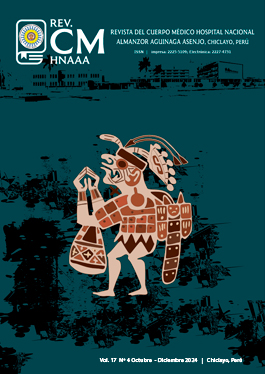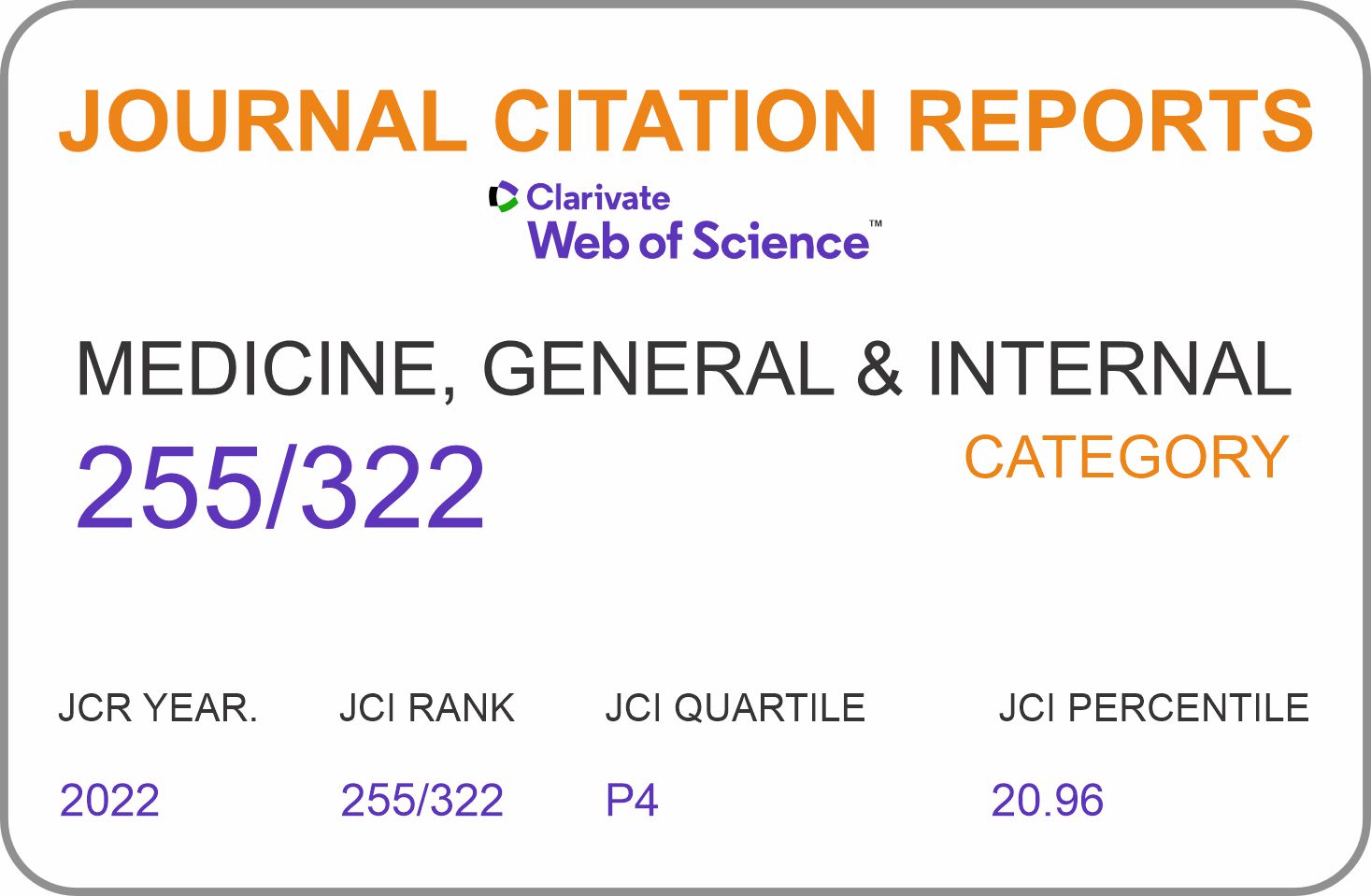Epidemiological situation of maternal deaths in Peru during 2015 and 2022 and analysis of two decades of years of life potentially lost.
DOI:
https://doi.org/10.35434/rcmhnaaa.2024.174.2179Keywords:
Maternal mortality, Years of Potential Life Lost, Perú, EpidemiologyAbstract
Introduction: Maternal mortality (MM) is considered a public health problem and is regarded as an indicator for global health status. The objective of this study was to determine the epidemiological situation of MM by calculating the maternal mortality ratio (MMR) and years of potential life lost (YPLL) in Peru from 2002 to 2022. Methods: A study was conducted using data from the Maternal Mortality Situational Room and the National Institute of Statistics and Informatics. MMR were calculated annually at both the national and departmental levels from 2015 to 2022, while YPLL were calculated for each year between 2 002 and 2 022 based on data availability. Results: The highest MMR was observed in 2 021 at 106.56. The departments with the highest MMRs in 2022 were Amazonas with 173.31 and Loreto with 117.48. Tacna and Moquegua had annual periods with no maternal deaths. Between 2002 and 2022, a total of 429,881.21 YPLLs were recorded, with 2022 having the lowest number of YPLLs at 13,932.43. The coefficient of determination was 0.57, indicating a decreasing trend. Conclusions: Maternal mortality showed a decrease over the study years, except for 2020 and 2021. Inequities persist among departments, with a significant difference in MMRs. YPLLs also significantly decreased over the study period. The age group with the highest loss was victims aged 20 to 24 years.
Downloads
Metrics
References
Organización Mundial de la Salud. Mortalidad materna [Internet]. 2023 [citado el 4 de julio de 2023]. Disponible en: https://www.who.int/es/news-room/fact-sheets/detail/maternal-mortality
Nuhu KM, McDaniel JT, Alorbi GA, Ruiz JI. Effect of healthcare spending on the relationship between the Human Development Index and maternal and neonatal mortality. Int Health. 2018;10(1):33–9. Doi:10.1093/inthealth/ihx053
Callister LC, Edwards JE. Sustainable Development Goals and the Ongoing Process of Reducing Maternal Mortality. J Obstet Gynecol Neonatal Nurs. 2017;46(3):e56–64. Doi: 10.1016/j.jogn.2016.10.009
Small MJ, Allen TK, Brown HL. Global disparities in maternal morbidity and mortality. Semin Perinatol. 2017;41(5):318–22. Doi: 10.1053/j.semperi.2017.04.009
Ozimek JA, Kilpatrick SJ. Maternal Mortality in the Twenty-First Century. Obstet Gynecol Clin North Am. 2018;45(2):175–86. Doi: 10.1016/j.ogc.2018.01.004
Lawrence ER, Klein TJ, Beyuo TK. Maternal Mortality in Low and Middle-Income Countries. Obstet Gynecol Clin North Am. 2022;49(4):713–33. Doi: 10.1016/j.ogc.2022.07.001
Direccion General de Epidemiología. Sala situacional de Muerte Materna [Internet]. CDC MINSA. 2023 [citado el 4 de julio de 2023]. Disponible en: https://www.dge.gob.pe/portalnuevo/publicaciones/salas-de-situacion/sala-situacional-de-muerte-materna/
Ramírez-Hernández H. Impacto de la pandemia por COVID-19 en gestantes peruanas: Un disparo en silencio. Rev Cuerpo Méd Hosp Nac Almanzor Aguinaga Asenjo. 2021;14:107–8. Doi: 10.35434/rcmhnaaa.2021.14sup1.1193
Hirshberg A, Srinivas SK. Epidemiology of maternal morbidity and mortality. Semin Perinatol. 2017;41(6):332–7. Doi: 10.1053/j.semperi.2017.07.007
Restrepo-Méndez MC, Victora CG. Maternal mortality by age: who is most at risk? Lancet Glob Health. 2014;2(3):e120-121. Doi: 10.1016/S2214-109X(14)70007-5
MacDorman MF, Declercq E, Thoma ME. Trends in Maternal Mortality by Sociodemographic Characteristics and Cause of Death in 27 States and the District of Columbia. Obstet Gynecol. 2017;129(5):811. Doi: 10.1097/AOG.0000000000001968
Gardner JW, Sanborn JS. Years of potential life lost (YPLL)--what does it measure? Epidemiol Camb Mass. 1990;1(4):322–9. Doi: 10.1097/00001648-199007000-00012
Gobierno del Perú. Gobierno oficializa fin del estado de emergencia por la covid-19 [Internet]. 2022 [citado el 4 de julio de 2023]. Disponible en: https://www.gob.pe/institucion/minsa/noticias/664735-gobierno-oficializa-fin-del-estado-de-emergencia-por-la-covid-19
World Health Organization. Indicator Metadata Registry Details [Internet]. 2024 [citado el 10 de julio del 2024]. Disponible en: https://www.who.int/data/gho/indicator-metadata-registry/imr-details/26
Martinez R, Soliz P, Caixeta R, Ordunez P. Reflection on modern methods: years of life lost due to premature mortality—a versatile and comprehensive measure for monitoring non-communicable disease mortality. Int J Epidemiol. 2019;48(4):1367–76. Doi: 10.1093/ije/dyy254
Román-Lazarte VE, Fernández-Fernández MF, Huanco-Apaza D. Tendencia y distribución regional de la mortalidad materna en el Perú: 2015-2019. Ginecol Obstet México. 2022;90(10):833–43. Doi: 10.24245/gom.v90i10.8037
Flores M, Garmendia ML, Flores M, Garmendia ML. Tendencia y causas de la mortalidad materna en Chile de 1990 a 2018. Rev Médica Chile. 2021;149(10):1440–9. Doi: 10.4067/s0034-98872021001001440
Kantor IN. Mortalidad materna en la Argentina. Med B Aires. [Interntet] 2020 [citado el 4 de Julio de 2023];80(2):171–2. Disponible en: http://www.scielo.org.ar/scielo.php?script=sci_abstract&pid=S0025-76802020000300013&lng=es&nrm=iso&tlng=es
Mitchell C. Pan American Health Organization / World Health Organization. 2019 [citado el 4 de julio de 2023]. OPS/OMS | La historia de Carla: Un freno a las muertes maternas en Bolivia. Disponible en: https://www3.paho.org/hq/index.php?option=com_content&view=article&id=14996:carla-s-story-putting-the-brakes-on-maternal-mortality-in- bolivia&Itemid=0&lang=es#gsc.tab=0
Gobierno del Perú. Directiva Sanitaria que Establece la Notificación e Investigación para la Vigilancia Epidemiológica de la Muerte Materna [Internet]. 2016 [citado el 4 de julio de 2023]. Disponible en: https://www.gob.pe/institucion/minsa/normas-legales/191744-778-2016-minsa
Banke-Thomas A, Avoka CK on, Gwacham-Anisiobi U, Omololu O, Balogun M, Wright K, et al. Travel of pregnant women in emergency situations to hospital and maternal mortality in Lagos, Nigeria: a retrospective cohort study. BMJ Glob Health. 2022;7(4):e008604. Doi: 10.1136/bmjgh-2022-008604
Masaba BB, Mmusi-Phetoe R, Rono B, Moraa D, Moturi JK, Kabo JW, et al. The healthcare system and client failures contributing to maternal mortality in rural Kenya. BMC Pregnancy Childbirth. 2022;22(1):903. Doi: 10.1186/s12884-022-05259-w
Pan American Health Organization. Nine strategic steps to reduce maternal mortality in the region. 2023. Disponible en: https://www.paho.org/en/news/23-5-2023-nine-strategic-steps-reduce-maternal-mortality-region
Aung EE, Liabsuetrakul T, Panichkriangkrai W, Makka N, Bundhamchareon K. Years of healthy life lost due to adverse pregnancy and childbirth outcomes among adolescent mothers in Thailand. AIMS Public Health. 2018;5(4):463–76. Doi: 10.3934/publichealth.2018.4.463
Direccion General de Epidemiología. [Internet] 2023 [citado el 4 de julio de 2023]. Sala situacional Covid-19. Disponible en: https://www.dge.gob.pe/covid19.html
Wang H, Paulson KR, Pease SA, Watson S, Comfort H, Zheng P, et al. Estimating excess mortality due to the COVID-19 pandemic: a systematic analysis of COVID-19-related mortality, 2020–21. The Lancet. 2022;399(10334):1513–36. Doi: 10.1016/S0140-6736(21)02796-3
Calvert C, John J, Nzvere FP, Cresswell JA, Fawcus S, Fottrell E, et al. Maternal mortality in the covid-19 pandemic: findings from a rapid systematic review. Glob Health Action. 2021;14(sup1):1974677. Doi: 10.1080/16549716.2021.1974677
Wen SW, Xie R. Maternal Mortality. En: Reference Module in Biomedical Sciences [Internet]. Elsevier; 2014 [citado el 4 de julio de 2023]. Disponible en: https://www.sciencedirect.com/science/article/pii/B9780128012383002634
Castro Baca ÁM, Villena Pacheco AE, Castro Baca ÁM, Villena Pacheco AE. La Pandemia del COVID-19 y su repercusión en la salud pública en Perú. Acta Médica Peru. 2021;38(3):161–2. Doi: 10.35663/amp.2021.383.2227
Smith ER, Oakley E, Grandner GW, Rukundo G, Farooq F, Ferguson K, et al. Clinical risk factors of adverse outcomes among women with COVID-19 in the pregnancy and postpartum period: a sequential, prospective meta-analysis. Am J Obstet Gynecol. 2023;228(2):161–77. Doi: 10.1016/j.ajog.2022.08.038
Pifarré I Arolas H, Acosta E, López-Casasnovas G, Lo A, Nicodemo C, Riffe T, et al. Years of life lost to COVID-19 in 81 countries. Sci Rep. 2021;11(1):3504. Doi: 10.1038/s41598-021-83040-3
Downloads
Published
How to Cite
Issue
Section
Categories
License
Copyright (c) 2025 Manuel Rueda-Camaná, Luz Angela Roman, Enrique Moncada-Mapelli, Maryorie Katteryne Galeas-Torre, Victor Roman-Lazarte

This work is licensed under a Creative Commons Attribution 4.0 International License.















